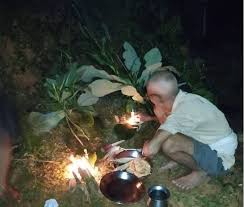Farmers in Nepal Celebrate Viral Festival to Banish Scabies After Muddy Monsoon Rice Planting

Kathmandu — The Luto Phalne festival, a peculiar tradition in Nepal, holds deep significance in the lives of rural Nepalis and is rooted in the country’s agricultural heritage, according to cultural experts. Celebrated on the evening of Saaune Sankranti, the festival involves worshipping the night god Kandarak.
Traditionally, the festival marks the end of the strenuous rice-planting season in Ashadh, during which farmers work barefoot in muddy water for long hours, exposing themselves to various skin diseases like scabies. To cleanse their bodies and protect against such ailments, Luto Phalne is observed as a day of purification.
From a religious perspective, Saaune Sankranti holds importance, making it an auspicious time for celebration. Puranas teacher Nawaraj Ghimire highlights the significance of this day in religious customs.
To perform the Luto Phalne tradition, a part of the front yard is smeared with cow or ox dung. Two balls of cow dung are prepared, adorned with cucumber flowers. Additionally, a taro leaf, green chili, peach, dropping fig (khanayo), and corn are placed on the smeared area.
Small bundles of thin bamboo stems are then taken to the kitchen to ignite the fire, which is later brought back and placed beside the cow dung balls. A mixture of mugwort (titepati) and ghee is burnt in this area. The burning torch is thrown away, and it is believed that the region it lands on becomes the kingdom of Sinjatpati, the birthplace of the Nepali language and Khas culture.
Furthermore, four torches from the kitchen stove are thrown in all four directions while chanting “Luto Laija” (Please take away scabies). The accompanying noise of drums, bells, and kitchen utensils adds to the festive atmosphere. Finally, a bundle of local herbs, including asparagus, is kept under the house’s roof to conclude the Luto Phalne festival.
Cultural expert Jagaman Gurung emphasizes that the Luto Phalne tradition encompasses psychological, religious, scientific, and cultural aspects of human life. It provides much-needed rest to exhausted farmers and allows them to partake in these rituals. Historian Dinesh Raj Panta points out the symbolic connection between nature, gods, and human health in this tradition.
Gurung explains that scientifically, heat or fire can destroy viruses, which aligns with the festival’s practice of destroying viruses on the land and in the air. The firing of bullets and the sound therapy created by bells, plates, and drums during the festival offer additional therapeutic benefits.
Although the Luto Phalne tradition is prevalent in western and eastern Nepal, it remains a relatively unknown affair in Kathmandu. This disparity is attributed to the scarcity of Khas people, specifically Brahmins and Chhetris, in the Kathmandu region. The Khas people, residing between Newars and ethnic groups such as Gurungs and Tamangs, might have abandoned the tradition due to their intermediate position.
While the Luto Phalne tradition may appear strange to the new generation, it holds deep cultural and agricultural significance, preserving a unique aspect of Nepal’s rural heritage.


















Facebook Comments